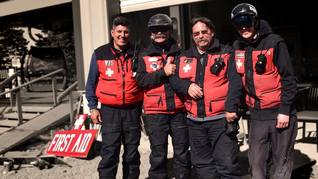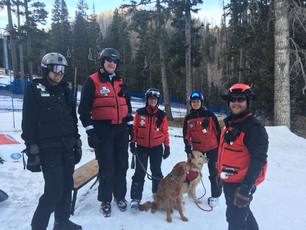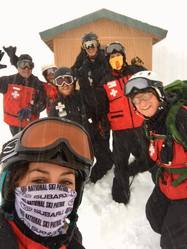The Role of the National Ski Patrol
The National Ski Patrol (NSP), founded in 1938, has followed its creed of "Service and Safety" since the establishment of skiing as a popular sport in the United States. As snowsports and guest services at areas have evolved over the years, so has the NSP, from a service organization to a modern-day professional education association. Other snowsports such as snowboarding, tubing, and snow-skating introduced new equipment and new terrain, which in turn required developing and teaching new safety and emergency care training methods. Increased access to the backcountry, beyond ski area boundaries, has also meant new training regimens for member of the NSP.
Today the organization is composed of more than 26,000 members serving over 600 patrols. These individuals include alpine, nordic and auxiliary patrollers who are paid or who volunteer their time throughout the United States and at certain military areas in Europe. The organization’s members are engaged in the promotion of safety programs across the outdoor recreation community. NSP members work on behalf of local ski and snowboard areas to improve the overall snowsports experience for outdoor recreationists. The National Ski Patrol has worked closely with other countries in outdoor emergency care education and has assisted in establishing patrol associations in Canada, Korea, New Zealand, Israel, Turkey, Argentina, and Chile as well as the Victorian Rescue Service in Australia.
The National Ski Patrol is a nonprofit organization, deriving its primary financial support from membership dues, donations, user fees, and corporate sponsorships. The national office is located in Lakewood, Colorado, and is staffed with full-time employees to handle administrative duties.
National Ski Patrol--Life of a Patroller--
http://www.youtube.com/watch?v=uOO9ZGqpDwM
Origins of the National Ski Patrol
The NSP was organized and directed by Charles Minot “Minnie” Dole as a committee of the National Ski Association (now the United States Ski Association). Through his efforts as the first national director of the NSP, the organization spread its effects and esprit de corps across the nation. Upon his retirement in 1950, Dole had built the NSP into an organization of 4,000 members serving 300 ski patrols. During World War II, Dole was responsible for the establishment of the famed 10th Mountain Division of the US Army. Applicants for this remarkable military unit, which saw much of its fighting activity in Italy, were screened by the NSP. Many individuals who were responsible for the establishment of many ski areas in the United States served in the 10th Mountain Division and have contributed significantly to the sport.
Thanks to this distinguished legacy of altruistic service, the National Ski Patrol was recognized with a federal charter by the United States Congress in 1980. This is a coveted endorsement that only a few other American institutions have earned, including the American Red Cross, the YMCA, and the Boy Scouts. The federal charter stipulates that the NSP continue to promote safety and health in skiing and other outdoor winter recreational activities. Accordingly, the NSP annually reports directly to Congress.
History of the Ski Apache Ski Patrol
The Ski Area which is known today as "Ski Apache" was born in 1961, when Robert O. Anderson cut a few trails and built a T-bar lift in an area where locals from Ruidoso had been coming to climb up the natural slopes and ski for some time. That first T-bar carried skiers up what is now "Easy Street." The State of New Mexico spent one million dollars to build an access road, hoping to develop recreational tourism up on the mountain and for the Ruidoso area. The construction of nine motel units completed the first phase of building and the area was named for the 12,003-foot mountain peak, Sierra Blanca.
A Roswell resident, Doug Kloxin, was one of the more frequent visitors, and his skiing experience while in the Wyoming area had shown him the value of a ski patrol. With the blessing of the area management, Doug brought Harvey Gill with him from Roswell and started looking for competent skiers. Several others were recruited to form this group of early patrollers. They wore armbands for identification, at first just a bandana tied around the sleeve and later an "official" red cross armband.
In 1963, Mr. Anderson sold the ski area to the Mescalero Apache tribe. Doug Kloxin continued to be the leader of the still loosely knit group of patrollers. By now, the members of the patrol were taking basic first aid courses from the Red Cross. In 1966, the patrol decided to join the national organization and officially became the "Sierra Blanca Ski Patrol." In 1985 the Apache tribal chieftain, Wendell Chino, changed the name of the area to "Ski Apache." Harvey Gill, one of the area's original patrollers, remained active with the Ski Apache Ski Patrol until his passing in 2011.
From its somewhat humble beginning, the Ski Apache patrol now annually registers over 80 members, who come from cities all over Texas, New Mexico, Arizona and Colorado. The camaraderie and cooperation between all of our patrollers, and the level of competency of the entire group, are achievements of which we are all extremely proud.



